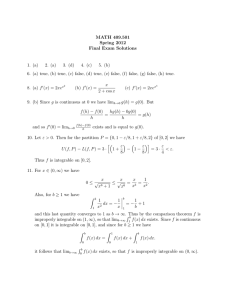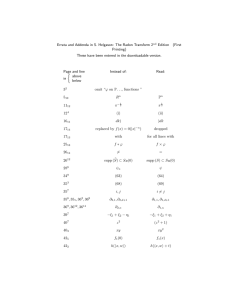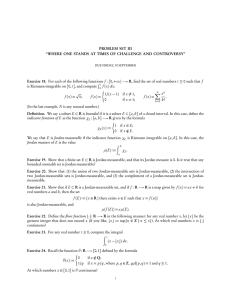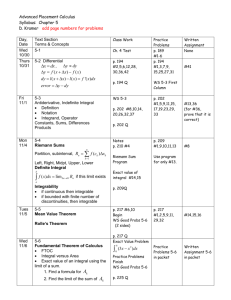Document 10514809
advertisement
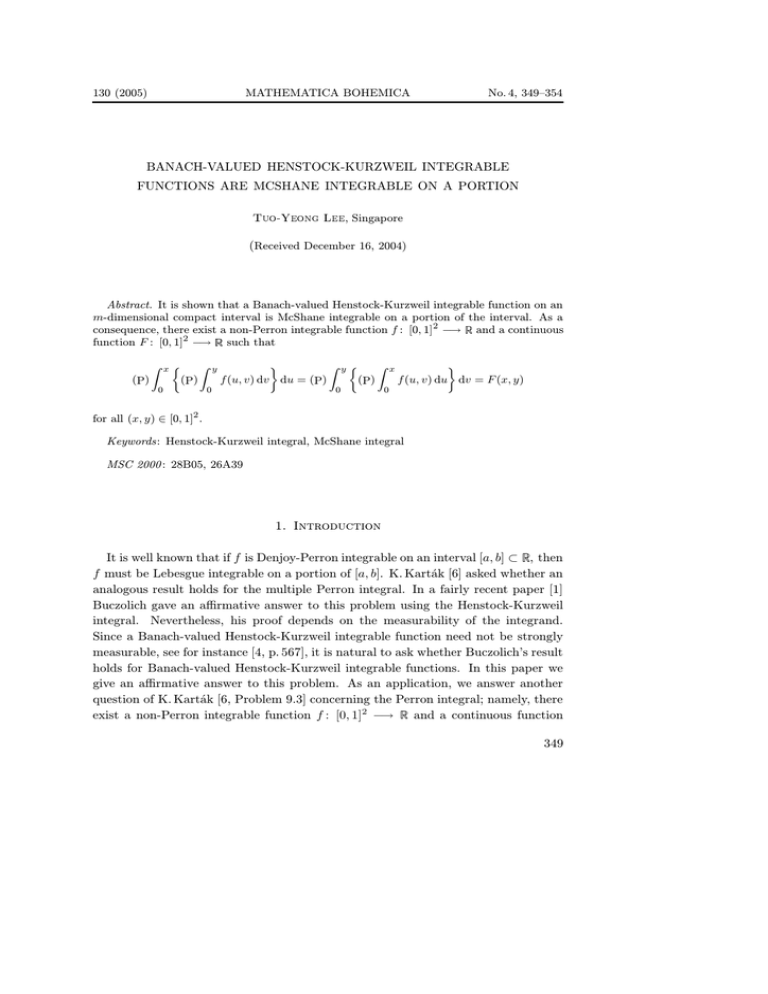
130 (2005)
MATHEMATICA BOHEMICA
No. 4, 349–354
BANACH-VALUED HENSTOCK-KURZWEIL INTEGRABLE
FUNCTIONS ARE MCSHANE INTEGRABLE ON A PORTION
, Singapore
(Received December 16, 2004)
Abstract. It is shown that a Banach-valued Henstock-Kurzweil integrable function on an
m-dimensional compact interval is McShane integrable on a portion of the interval. As a
consequence, there exist a non-Perron integrable function f : [0, 1]2 −→ and a continuous
function F : [0, 1]2 −→ such that
(P )
Z
x
(P )
0
Z
y
0
Z
f (u, v) dv du = (P)
y
0
Z
(P )
x
0
f (u, v) du dv = F (x, y)
for all (x, y) ∈ [0, 1]2 .
Keywords: Henstock-Kurzweil integral, McShane integral
MSC 2000 : 28B05, 26A39
1. Introduction
It is well known that if f is Denjoy-Perron integrable on an interval [a, b] ⊂ , then
f must be Lebesgue integrable on a portion of [a, b]. K. Karták [6] asked whether an
analogous result holds for the multiple Perron integral. In a fairly recent paper [1]
Buczolich gave an affirmative answer to this problem using the Henstock-Kurzweil
integral. Nevertheless, his proof depends on the measurability of the integrand.
Since a Banach-valued Henstock-Kurzweil integrable function need not be strongly
measurable, see for instance [4, p. 567], it is natural to ask whether Buczolich’s result
holds for Banach-valued Henstock-Kurzweil integrable functions. In this paper we
give an affirmative answer to this problem. As an application, we answer another
question of K. Karták [6, Problem 9.3] concerning the Perron integral; namely, there
exist a non-Perron integrable function f : [0, 1]2 −→ and a continuous function
349
F : [0, 1]2 −→ such that
(P)
Z
x
0
(P)
Z
y
f (u, v) dv du = (P)
0
Z
y
0
(P)
Z
x
f (u, v) du dv = F (x, y)
0
for all (x, y) ∈ [0, 1]2 .
2. Preliminaries
Unless stated otherwise, the following conventions and notation will be used. The
set of all real numbers is denoted by , and the ambient space of this paper is m ,
where m is a fixed positive integer. The norm in m is the maximum norm ||| · |||,
where |||(x1 , x2 , . . . , xm )||| = max |xi |. For x ∈ m and r > 0, set B(x, r) := {y ∈
m
i=1,...,m
m
Q
[ai , bi ] be a fixed non-degenerate interval in : |||y − x||| < r}. Let E :=
m
. Let
i=1
X be a Banach space equipped with a norm k · k. A function is always X-valued.
When no confusion is possible, we do not distinguish between a function defined on
a set Z and its restriction to a set W ⊂ Z.
An interval in m is the cartesian product of m non-degenerate compact intervals
in , I denotes the family of all non-degenerate subintervals of E. For each I ∈ I,
|I| denotes the volume of I.
A partition P is a collection {(Ii , ξi )}pi=1 , where I1 , I2 , . . . , Ip are non-overlapping
non-degenerate subintervals of E. Given Z ⊆ E, a positive function δ on Z is called
a gauge on Z. We say that a partition {(Ii , ξi )}pi=1 is
p
S
(i) a partition in Z if
Ii ⊆ Z,
(ii) a partition of Z if
i=1
p
S
Ii = Z,
i=1
(iii)
(iv)
(v)
(vi)
anchored in Z if {ξ1 , ξ2 , . . . , ξp } ⊂ Z,
δ-fine if Ii ⊂ B(ξi , δ(ξi )) for each i = 1, 2, . . . , p,
Perron if ξi ∈ Ii for each i = 1, 2, . . . , p,
McShane if ξi need not belong to Ii for all i = 1, 2, . . . , p.
According to Cousin’s Lemma [8, Lemma 6.2.6], for any given gauge δ on E, δ-fine
Perron partitions of E exist. Hence the following definition is meaningful.
Definition 2.1.
A function f : E −→ X is said to be Henstock-Kurzweil
integrable (McShane integrable, respectively) on E if there exists A ∈ X with the
following property: given ε > 0 there exists a gauge δ on E such that
X
p
f (ξi )|Ii | − A
<ε
i=1
350
for each δ-fine Perron partition (δ-fine McShane partition, respectively) {(Ii , ξi )}pi=1
R
R
of E. We write A as (HK) E f (M) E f , respectively .
It is well known that if f is Henstock-Kurzweil integrable on E, then f is HenstockKurzweil integrable on each subinterval J of E. Moreover, the interval function
R
J 7→ (HK) J f is additive on I. This interval function is known as the indefinite
Henstock-Kurzweil integral, or in short the indefinite HK-integral, of f .
Theorem 2.2 (Saks-Henstock Lemma). Let f : E −→ X be Henstock-Kurzweil
integrable on E and let F be the indefinite HK-integral of f . Then given ε > 0 there
exists a gauge δ on E such that
X
<ε
{f
(x)|I|
−
F
(I)}
(I,x)∈P
for each δ-fine Perron partition P in E.
3. Banach-valued Henstock-Kurzweil integrable functions are
McShane integrable on a portion
Theorem 3.1. Let f : E −→ X be Henstock-Kurzweil integrable on E and let F
denote the indefinite Henstock-Kurzweil integral of f . Then the following conditions
are equivalent:
(i) f is McShane integrable on E;
q
P
(ii) sup k
F (Ji )k is finite, where the supremum is taken over all finite partitions
i=1
{J1 , . . . , Jq } of pairwise non-overlapping subintervals of E.
.
Since E is compact, the implication (i) =⇒ (ii) follows from [11,
Lemma 28].
(ii) =⇒ (i). Assume (ii). If x ∈ X ∗ , then x(f ) is Henstock-Kurzweil integrable
on E and the indefinite Henstock-Kurzweil integral of x(f ) is of bounded variation
on E. The rest of the proof is similar to that of the implication (iii) =⇒ (i) of [2,
Corollary 9]. The proof is complete.
In view of [3, Proposition 2B], the next theorem is a mild improvement of [2,
Theorem 8].
351
Theorem 3.2. Let f : E −→ X be Henstock-Kurzweil integrable on E and let F
denote the indefinite Henstock-Kurzweil integral of f . Then the following conditions
are equivalent:
(i) f is McShane integrable on E;
(ii) F is absolutely continuous on I, that is, given any ε > 0 there exists δ > 0
p
P
such that the inequality k
F (Ii )k < ε holds whenever {I1 , . . . , Ip } is a finite
i=1
collection of pairwise non-overlapping subintervals of E with
p
P
|Ii | < δ.
i=1
. (i) =⇒ (ii). This follows from [11, Lemma 28].
(ii) =⇒ (i). Since E is compact, this follows from Theorem 3.1.
It is well known that the real-valued McShane integral is equivalent to the Lebesgue
integral. For a proof of this result, see, for example, [10]. Hence the following theorem
is a generalization of [1, Theorem]. Recall that a portion of E is a set of the form
E ∩ I, where I is an open interval in m .
Theorem 3.3. If f : E −→ X is Henstock-Kurzweil integrable on E, then f is
McShane integrable on a portion of E.
. Since f is assumed to be Henstock-Kurzweil integrable on E, the SaksHenstock Lemma (Theorem 2.2) holds. Therefore there exists a gauge δ on E such
that
X
{f (x)|I| − F (I)}
<1
(I,x)∈P
for each δ-fine Perron partition P in E. For each n ∈ , we set
n
1o
Xn = x ∈ E : kf (x)k < n and δ(x) >
.
n
Clearly
S
n∈
Xn = E and hence by Baire’s Category Theorem [5, Theorem 5.2]
there exists N ∈ such that XN is dense on some J belonging to I. Without loss of
generality we may assume that diam(J) < 1/N , where diam(J) denotes the diameter
of J.
Consider any finite collection {J1 , . . . , Jq } of pairwise non-overlapping subintervals
of J. For each i ∈ {1, . . . , q} we invoke the density of XN ∩J in J to pick xi ∈ XN ∩J.
Since diam(J) < 1/N , we see that {(J1 , x1 ), . . . , (Jq , xq )} is a (1/N )-fine, and hence
δ-fine, Perron partition anchored in XN ∩ J. Hence, by our choice of δ,
X
q
{f (xi )|Ji | − F (Ji )}
<1
i=1
352
and so
X
q
X
q
kf (xi )k|Ji | < 1 + N |J|.
F
(J
)
<
1
+
i i=1
i=1
As {J1 , . . . , Jq } is an arbitrary finite collection of pairwise non-overlapping subintervals of J, an appeal to Theorem 3.1 completes the proof of the theorem.
In [7], Kurzweil and Jarník proved that if f is a real-valued Henstock-Kurzweil
integrable function on E, then there exists an increasing sequence {Xn }∞
n=1 of closed
sets whose union is E, and for each n ∈ , f is Lebesgue integrable on Xn . Hence
it is natural to pose the following problem.
3.4. Let f : E −→ X be Henstock-Kurzweil integrable on E. Can we
find an increasing sequence {Xn }∞
n=1 of closed sets whose union is E, and for each
n ∈ , f is McShane integrable on Xn ?
4. On a question of K. Karták concerning the Perron integral
K. Karták posed the following problem for the Perron integral:
4.1 [6, Problem 9.3]. Is there a function f : [0, 1]2 −→ such that
Z x
Z y
Z y
Z x
f (u, v) du dv = F (x, y)
(P)
f (u, v) dv du = (P)
(P)
(P)
0
0
0
0
for all (x, y) ∈ [0, 1]2 and that the function F is continuous on [0, 1]2 while f is not
Perron integrable on [0, 1]2 ?
Recall that the real-valued Henstock-Kurzweil integral is equivalent to the Perron
integral. Hence we may use the Henstock-Kurzweil integral to answer the above
question of K. Karták.
Theorem 4.2. There exist f : [0, 1]2 −→ and a continuous function F :
[0, 1]2 −→ such that
Z x
Z y
Z y
Z x
(1) (HK)
(HK)
f (u, v) dv du = (HK)
(HK)
f (u, v) du dv
0
0
0
0
= F (x, y)
for all (x, y) ∈ [0, 1]2 but f is not Henstock-Kurzweil integrable on [0, 1]2 .
. Let f be given as in [12, Chapter VI]. Then there exist a continuous
function F : [0, 1]2 −→ and f : [0, 1]2 −→ such that
∂ 2 F (x, y)
∂ 2 F (x, y)
=
= f (x, y)
∂x∂y
∂y∂x
353
for all (x, y) ∈ (0, 1)2 . Moreover, f is not Lebesgue integrable, and hence not McShane integrable, on any non-degenerate subinterval of [0, 1]2 . It is clear that (1)
holds for all (x, y) ∈ [0, 1]2 . Using Theorem 3.3 with E = [0, 1]2 and X = , we
conclude that f cannot be Henstock-Kurzweil integrable on [0, 1]2 . The proof is
complete.
In view of [9, Theorem 4.3] and [9, Theorem 4.1], we see that every real-valued
indefinite Henstock-Kurzweil integral generates a σ-finite Henstock variational measure. Thus it is natural to pose the following problem.
4.3. Let F be given as in Theorem 4.2, and let Fe be the additive
interval function induced by F . Must the Henstock variational measure VHK Fe be
σ-finite on [0, 1]2 ?
References
[1] Z. Buczolich: Henstock integrable functions are Lebesgue integrable on a portion. Proc.
Amer. Math. Soc. 111 (1991), 127–129.
[2] D. H. Fremlin: The Henstock and McShane integrals of vector-valued functions. Illinois
J. Math. 38 (1994), 471–479.
[3] D. H. Fremlin, J. Mendoza: The integration of vector-valued functions. Illinois J. Math.
38 (1994), 127–147.
[4] R. A. Gordon: The McShane integral of Banach-valued functions. Illinois J. Math. 34
(1990), 557–567.
[5] R. A. Gordon: The Integrals of Lebesgue, Denjoy, Perron, and Henstock. Graduate Studies in Mathematics Volume 4, AMS, 1994.
[6] K. Karták: Zur Theorie des mehrdimensionalen Integrals. Časopis Pěst. Mat. 80 (1955),
400–414. (In Czech.)
[7] J. Kurzweil, J. Jarník: Equi-integrability and controlled convergence of Perron-type integrable functions. Real Anal. Exchange 17 (1991/92), 110–139.
[8] Peng-Yee Lee, R. Výborný: The integral, An Easy Approach after Kurzweil and Henstock. Australian Mathematical Society Lecture Series 14 (Cambridge University Press,
2000).
[9] Tuo-Yeong Lee: A full descriptive definition of the Henstock-Kurzweil integral in the
Euclidean space. Proc. London Math. Soc. 87 (2003), 677–700.
[10] Tuo-Yeong Lee: Some full characterizations of the strong McShane integral. Math. Bohem. 129 (2004), 305–312.
[11] Š. Schwabik, Guoju Ye: The McShane and the Pettis integral of Banach space-valued
functions defined on m . Illinois J. Math. 46 (2002), 1125–1144.
[12] G. P. Tolstov: On the curvilinear and iterated integral. Trudy Mat. Inst. Steklov. 35
(1950), 102 pp. (In Russian.)
Author’s address: Tuo-Yeong Lee, Mathematics and Mathematics Education, National
Institute of Education, Nanyang Technological University, 1 Nanyang Walk, Singapore
637616, Republic of Singapore, e-mail: tylee@nie.edu.sg.
354

